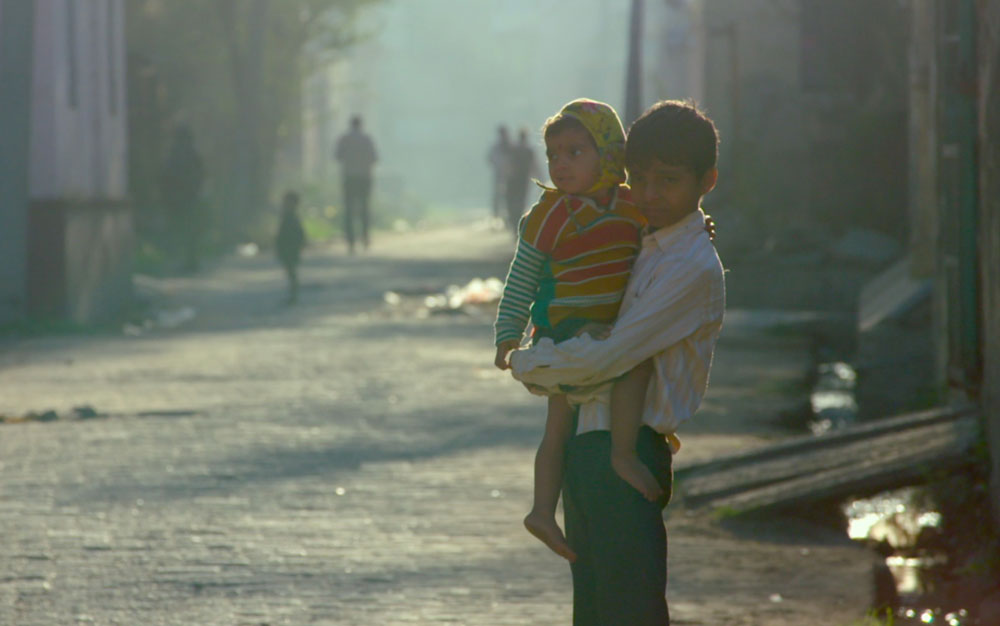The most harrowing moment in “Invisible Hands” is something Shraysi Tandon barely caught on camera. The longtime journalist for the likes of ABC News and Bloomberg TV was tracing the supply chains that yield the chocolate bar you recently nibbled on from an American chocolatier to the cocoa fields in Ghana where there’s a strong possibility it was harvested by a prepubescent child, when she stumbled into a unique opportunity with the help of a local journalist known as Anas Aremeyaw Anas. After presenting themselves as cocoa farm owners from abroad, they received an offer to purchase some kids for a mere fee just over $500 U.S. each and while they were eager to pay for their freedom, collecting evidence of the traffickers who were doing the selling was making them nervous.
“The opportunity to purchase trafficked children is not something you get to do every day, whether you work in that field or even as a filmmaker,” says Tandon. “So I considered myself to be very fortunate to be in that position, but at the same time, it was quite horrific and film is such a visual medium to show in order to tell, but we tried to show as much of it as we could.”
Tandon ultimately resorted to title cards to put the sale into context for audiences, but the footage made complete sense to the local authorities who were able to take subsequent action, something that the filmmaker has continued to push for with the release of “Invisible Hands,” which travels around the globe to connect the dots between the goods we buy and their often ugly means of production. Whether it’s t-shirts or tobacco, Tandon uncovers teenagers and younger doing work well beyond their years and discovers that while laws may be in place to prevent such abuse, enforcement of them may be weak and companies that tout child labor policies publicly can easily use shadowy subcontractors who prey upon minors.
Even corporate programs that seem on the level, such as unpaid internships from vocational schools in China are questioned as a funnel for exploitative labor practices and “Invisible Hands” continually exposes the business models built on child labor and how they’ve been normalized, even in America. Yet as dire as a portrait as Tandon paints, she highlights those who have had success in fighting against it, profiling the Indian child rights activist Kailash Satyarthi and interviewing the likes of New York Times columnist Nicholas Kristof and Ben Skinner, the founder of the nonprofit Transparentem. With the final film now making its way around the world, the director spoke about why she had less trouble than you may think bringing cameras into certain situations while others proved nearly impossible, connecting the dots of supply chains and the transition from news reporting to filmmaking.
I’ve been a journalist for almost a decade now and a few years ago, I interviewed Kailash Satyarthi, the Nobel Peace Prize winner, and was really blown away by the work that he had done rescuing 87,000 children around the world. I had heard that modern slavery was still well and alive, but to actually be sitting next to someone who took the law into his own hands in a lot of ways and is trying to eradicate the wrongs being done to the children, I was really moved by his story. I was convinced in that moment that the film I was going to make was more of a biopic of [Satyarthi] and his life and his accomplishments, but as we started developing the story and my producer Charles Ferguson came onboard, he had suggested to me that it would be better for us to make a movie on a global scale to show just how widespread [child labor] is. I was [already] a little embarrassed because I consider myself a well-read person, yet had no idea just how prevalent this issue really was, so that really started to get my wheels turning about making the feature doc.
What was it then like to figure out the logistics of such an international story?
Logistically, it was very challenging to make this film because we filmed in so many countries around the world, but that was really important because I wanted to be very clear that this was not just taking place in one or two countries, but it was an infuriating global phenomenon that was occurring. It’s not just as we normally think an Africa or an Asia problem, but that Western corporations and even countries like the United States are very much the culprit here as well and we were blessed with an incredible team of journalists, investigative reporters and NGO workers and executives and activists who gave us tremendous access.
You have to dig and do your due diligence because [the supply chains] can get quite convoluted, especially when you start going down to the rural parts of countries in Africa and Asia. When you’re going to places where there’s just one or two buyers of your product, that becomes really hard to make that connection, but when you are covering the story in countries where they are the largest sellers or producers, then it gets very easy to piece it together. For example when we were in Cote d’Ivoire and Ghana, one of the largest cocoa producers in the entire world, they account for 60 precent of all the chocolate we consume and when you are on the ground going to the cocoa fields and farms, it’s very easy once you start speaking to a lot of the people there — the farm manager, the factory owners — where is this cocoa going to? Who’s buying it? Where are you selling it? Who’s picking up the product? So in that sense, that became easier to do.

Yes, absolutely [because] you cannot go in and speak with authority unless you’ve actually physically been there. Although I read so many news stories and reports put out by the United Nations or UNICEF or Human Rights Watch or Amnesty International, at the end of the day those reports, they were still dated by the time I was reading them, even though they were dated by a couple of months. So for me to contact corporations and executives and have those conversations with people or try to get them to speak to us on camera, I felt like I was only able to do that with a lot of certainty is if I have seen it for myself and it only strengthens the case for your storytelling and what it is you’re trying to show.
It looked like much of this was shot covertly, particularly the scenes in America. How did you manage that?
The footage you’re referring to is actually from North Carolina. We were on the tobacco farms there and a lot of that footage was taken with hidden cameras, as was a lot of the footage in Indonesia and Ghana. For the most part, I think there are places where you could go into the world and people have no idea that what they’re doing is wrong or illegal in any which way, so it’s business as usual and they’re quite happy to be on camera. But there are also places where people do get nervous when they see a camera crew, especially when that field or factory is connected to a billion dollar corporation. Then you don’t always get the friendliness and the access that you hope for, so the only way to circumvent that is to go in with hidden cameras in order to collect footage.
Coming from a news background as you do, did making a documentary feature come naturally or was it an adjustment?
It came quite naturally because the reality with doc filmmaking is I’m not writing a script or creating characters — if I had to do that, it would be far more challenging. I always look at real people as characters and real lives as plots and that’s what I’ve done in television news is tell stories that are happening often in real time. The only challenge was starting to think in a one-and-a-half, two-hour setting versus a five-minute news segment, and to really try and expand your vision, [as well as] being able to tell it cinematically, to show [an audience] images and introduce them to people that would capture their interest as opposed to just a really quick and dirty “this is what’s happening and this is why.”
The film recently played at the Bali International Film Festival in Indonesia. What’s it like showing the film in a country where you highlight these immoral practices?
Yes, the film had its Asia premiere there and I was certainly a little anxious and nervous because I was very aware of all the hoops we had to jump through in order to make that happen. Honestly, when we were being considered for the Bali Film Festival, we were waiting for a certification to come through from the Indonesia government [which] is mandatory for all films screening in a theatrical venue. The government has to greenlight it. It’s their media and information body, and I wasn’t sure if we were going to get greenlit to even show in Bali, even though our film was selected, so when that certification came through, I was very pleased and then I was even more surprised and pleased that the film won Best Documentary. It showed to me that there was no intent of a cover-up or to silence or censor the film there. Indonesia is one of the largest democracies in the world with 260 million people and counting, but at the same time, it is a developing country, so democracy is not perfect, but I was very happy to see how it played out and how well-received it was.
Of course, I’m ashamed to live in a country where, as you uncover, this happens too.
Yeah, the most surprising gasps I get are from people who watch it in the States. That’s where the audience reaction has been tremendous because, again, everyone associates human rights abuses and issues like child labor and child trafficking as a problem that’s happening in other remote or developing countries, but it’s happening in our backyard in North Carolina, Tennessee and Kentucky and parts of California, and seeing people react to that for me is always the most fun.
“Invisible Hands” opens in Los Angeles on November 30th at the Laemmle Glendale.





